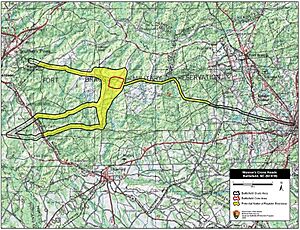Battle of Monroe's Crossroads facts for kids
Quick facts for kids Battle of Monroe's Crossroads |
|||||||
|---|---|---|---|---|---|---|---|
| Part of the Campaign of the Carolinas | |||||||
|
|||||||
| Belligerents | |||||||
| Commanders and leaders | |||||||
| Hugh Judson Kilpatrick | Wade Hampton Joseph Wheeler |
||||||
| Units involved | |||||||
| Kilpatrick’s Cavalry Division | Wheeler’s Cavalry Division Hampton’s Cavalry Division |
||||||
| Strength | |||||||
| 1,850 | 3,000 | ||||||
| Casualties and losses | |||||||
| 183 | 86 | ||||||
The Battle of Monroe's Crossroads was an important fight during the American Civil War. It happened on March 10, 1865, in Hoke County, North Carolina. This battle is also called the Battle of Fayetteville Road. Some people in the North even called it "Kilpatrick's Shirttail Skedaddle."
This battle took place on what is now Fort Bragg Military Reservation. About 4,500 soldiers fought here. It was a clash between mounted Confederate cavalry and dismounted Union cavalry. This makes it one of the last big cavalry battles of the Civil War. The fighting lasted for several hours early in the morning. The battle ended without a clear winner. However, the Confederate attack did slow down the Union cavalry. This prevented Union Maj. Gen. Hugh Judson Kilpatrick from being the first to enter Fayetteville.
The Battle Begins
The main Confederate attack started at dawn. It surprised the Union camp, which was not well-guarded. Many Union soldiers were still sleeping. Confederate forces were led by Lt. Gen. Wade Hampton and Maj. Gen. Joseph Wheeler. This was their first time working together in battle.
One of their goals was to capture General Kilpatrick himself. They used a small group of specially chosen soldiers for this mission. Kilpatrick was staying in a small log cabin near the Monroe farmhouse. When the attack began, he had to quickly escape the chaos. He hid for a while in a nearby swamp. After things calmed down, he was able to get his troops back in order.
Union Counterattack
At first, the Union cavalry was scattered and confused. But they quickly regrouped and fought back. They pushed the Confederates out of their camp. The Confederate commanders knew that Union infantry was getting close. So, they ordered their troops to leave the battle by mid-morning. Hampton's cavalry then moved in an organized way towards Fayetteville.
Several Confederate generals were wounded during the battle. These included Brig. Gen. Thomas Harrison, Brig. Gen. William Y.C. Humes, and Col. James Hagan. Col. Moses W. Hannon was also wounded. Brig. Gen. William W. Allen and Col. Henry Marshall Ashby were injured when their horses were shot from under them.
What Happened Next
The Battle of Monroe's Crossroads gave the Confederate infantry valuable time. It allowed them to cross the Cape Fear River at Fayetteville safely. The Union forces could not bother them during this crossing. Once their soldiers and equipment were on the east side of the Cape Fear River, the Confederates burned the bridges. This happened just as Union forces entered the city.
Today, you can still see the graves of several unidentified Union soldiers. They are in the training area of Fort Bragg. This is a few miles south of the Normandy Dropzone. If you wish to visit, you must get approval from range control.


